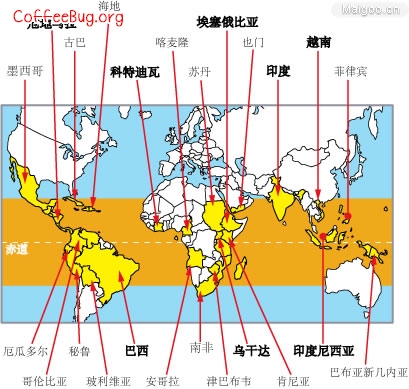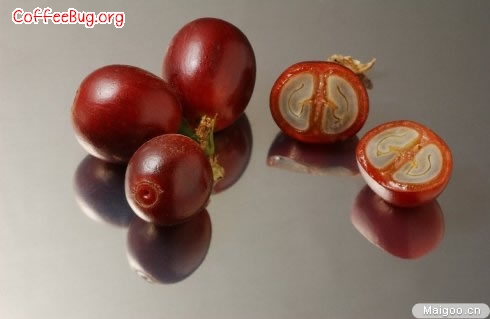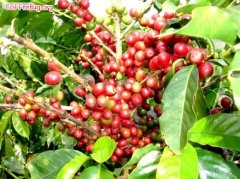The basic knowledge of coffee beans the cultivation conditions of coffee coffee belt
There is a noun called "Coffee Belt". There are more than 60 coffee producing countries in the world, most of which are located in the tropics and subtropics between the Tropic of Cancer (23 °26 'north and south). This coffee growing area is called a "coffee belt" or "coffee area" (Coffee Zone).

The annual average temperature of the coffee belt is above 20 ℃, because the coffee tree is a tropical plant and cannot grow normally if the temperature is below 20 ℃.
1. Climatic conditions
Arabica coffee is not resistant to high temperature and humid climate, nor can it stay at a low temperature below 5 ℃ for a long time, so it is planted on steep slopes of 1000 to 2000 meters above sea level. On the other hand, Robusta caffeine is adaptable (Robusta originally means "tenacious and strong") and is mostly grown in lowlands below 1000 meters above sea level.
The average annual rainfall of 1000 mm to 2000 mm, coupled with moderate sunshine, is the most suitable environment for coffee growth. However, Arabica coffee is not resistant to strong sunlight and extreme heat, so it is suitable for growing in terrain prone to morning fog, especially where there is a large temperature difference between day and night. In addition, some places will plant shelter trees in order to avoid direct sunlight, such as bananas, maize, mango trees and so on.

two。 Soil quality
To put it simply, the soil suitable for growing coffee is fertile volcanic soil with enough moisture and moisture, and rich in organic matter. The Ethiopian plateau is covered with this kind of volcanic weathered soil, so the soil rich in humus is naturally one of the basic conditions for growing coffee.
In fact, the main coffee-producing areas in the highlands of Brazil (called "Terra rossa", meaning fertile red soil weathered by basalt), the highlands of Central America, around the Andes of South America, the African highlands, the West Indies, Java (some of the soils are also weathered by volcanic rocks, or a mixture of volcanic ash and humus), and the Ethiopian highlands, have fertile soils with plenty of water.
Soil has a subtle effect on the taste of coffee. For example, the acidity of coffee grown on slightly acidic soil will also be strong; for example, the soil around Rio de Janeiro in Brazil has an iodine flavor, and the coffee will also be contaminated with that unique flavor by shaking the fruit to the ground when picking coffee beans.
3. Topography and height
It is generally believed that the coffee produced in the highlands is of better quality. Coffee-producing countries in Central America will use "elevation" as the grading standard because there are mountains crossing from the center of the continent. For example, SHB (Strictly Hard Bean) in Guatemala, the highest of the seven grades, is called SHB, which represents that its producing area is about 1370 meters above sea level.
Although the coffee farm is located on steep slopes and is not convenient for transportation, transportation, cultivation and management, this terrain has low temperatures and is prone to morning fog, which can ease the strong sunshine peculiar to the tropics and allow time for the coffee fruit to fully mature.
However, high-grade coffee such as "Blue Mountain" and "Hawaiian Kona" on the island of Jamaica are not harvested in the highlands. Because as long as there is the right temperature, rainfall and soil, there will be morning fog and a large temperature difference between day and night, high-quality coffee can be grown. It can be seen that even if "high real estate equals high quality", it does not mean that "low real estate equals low quality". Elevation can only be regarded as one of the reference criteria for judging the grade of coffee. Although elevation is important, the topography and climatic conditions of the producing area are more important.
European countries, the main consumer of coffee, gave high praise to highland coffee such as Kenya and Colombia a long time ago. Quantitative coffee beans can extract more coffee liquid (that is, higher concentration), which is one of the reasons why Highland Coffee is well received.
In addition, as mentioned earlier, Robusta coffee, which is native to the Congo, is grown in the lowlands below 1000 meters above sea level. Unlike Arabica, it grows fast and is resistant to diseases and insect pests, and can be grown in non-fertile soil. Therefore, the taste and aroma are far inferior to Arabica coffee.

The cultivation process of Coffee
People often mistakenly think that coffee is grown directly with raw beans, but it takes a long time to grow coffee only to find that it doesn't sprout. In fact, coffee is grown with seeds with endocarp (Parchment). "Inner fruit" (or "sheepskin" or "paper skin") refers to the tea-brown hard skin that wraps the coffee seeds, and the coffee beans attached to that layer are called "Parchment Bean".

Plucking the skin of the fully ripe bright red coffee fruit (called red cherry), you can see that there is yellow flesh under the red skin, which is a bit like a cherry, the flesh is sweet, there is a pair of symmetrical seeds in the center, and there is a slippery film around the seeds. Wash the film off with water to become "shelled beans". Peel off the endocarp and you will see the seeds covered with Silver Skin. The seed is the raw bean actually used as the raw material of coffee.


1. Sowing seeds
The coffee wrapped with endocarp will be planted in the seedbed (a plastic flowerpot called "pot") and will germinate in 40 to 60 days and grow to about 50 centimeters in about 6 months after germination. At this stage, the seedlings are still fragile and must be covered with cold gauze and other things to block direct sunlight.
The seedlings blossomed about three years after they were transplanted from the seedbed to the garden. During this period, countries such as Central America that use hand-picking to harvest coffee beans will prune the branches of coffee trees and remove the lower side branches in order to improve the efficiency of harvesting coffee. The flowers of the coffee tree are white five-petal flowers with a jasmine scent. The flowers wither in a few days, then grow small fruits, and turn red in 6 to 8 months to represent maturity.
The peak of the coffee harvest is in the 6-10 years after the coffee tree grows, and then the harvest will gradually decline. In addition, if the coffee tree grows too high, it will also lead to a poor harvest, so coffee farmers will cut off the trunk from 30cm to 50cm above the ground, allowing it to regenerate branches and renew productivity. This step is called "Cutback". If combined with climate, fertilization, resistance to diseases and insect pests and other favorable conditions, coffee trees can last 20 years, or even 50 years of continuous fruit.
Wild coffee trees can be as high as 10 meters, but generally planted coffee trees are maintained at a height of about 2 meters in order to harvest conveniently. Arabica coffee varieties are being improved year after year, hoping to reach the level of high harvest, high virus resistance, early harvest, strong environmental adaptability, and, of course, the appropriate height of trees to make harvesting more efficient.
two。 Harvest
The harvest time and method of coffee vary from place to place, generally speaking, about once or twice a year (sometimes up to three or four times). The harvest time is mostly in the dry season. In Brazil, for example, around June, it starts in the north-eastern state of Bahia and ends in October in the southern state of Parana. The harvest period of Central American countries is from September to January of the following year, from lowlands to highlands.
Harvesting methods can be divided into two categories, one is hand picking method, the other is shaking method.
(1) hand picking
With the exception of Brazil and Ethiopia, most Arabica coffee-producing countries are harvested by hand. Hand picking involves not only picking ripe bright red coffee fruits, but also sometimes along with immature cyan coffee fruits and branches, so these immature beans are often mixed with refined coffee beans, especially when refined by natural methods. If these beans are mixed with baking, they will produce a disgusting stench.
(2) shake-down method
This method is to hit the ripe fruit or shake the coffee branch with a random stick, so that the fruit falls and accumulates into a pile. Larger estates will use large harvesters, while small and medium-sized farms will harvest with a sea of people mobilized by the whole family. This method of shaking the fruit off the ground is easier to mix with impurities and defective beans than the hand-picking method, and beans from some places can be stained with a strange smell or fermented because the ground is wet. Producers of Robusta coffee beans such as Brazil and Ethiopia are mostly harvested in this way.
Countries harvested by shaking and falling method also use natural drying method to refine coffee beans. Coffee blossoms in spring, bears fruit in summer and harvests in winter, so it is very difficult to harvest and dry in places where there is no clear distinction between drought and rainy seasons. in the rainy season, it is impossible to use natural drying. Therefore, coffee is suitable for growing in areas with distinct dry and rainy seasons.

Important Notice :
前街咖啡 FrontStreet Coffee has moved to new addredd:
FrontStreet Coffee Address: 315,Donghua East Road,GuangZhou
Tel:020 38364473
- Prev

The basics of coffee beans the three native species of coffee
Coffee belongs to the evergreen shrub of the genus Rubiaceae, which is centered in the tropics. There are about 6000 species of Rubiaceae belonging to 500 genera. Coffee has always been thought to have certain effects, such as strengthening the stomach, waking up the brain, stopping bleeding, dissipating heat, strengthening the body, and so on. The more famous Rubiaceae plant is Gardenia jasminoides, whose fruit was dried and used as medicinal material a long time ago. The three native species of coffee
- Next

The characteristics and Development History of Coffee basic knowledge White Coffee
The history and origin of white coffee is a native product of Malaysia with a history of more than 100 years. White coffee does not mean that the color of coffee is white, but uses high-grade Liberica, Arabica and Robusta coffee beans and super skim cream raw materials to remove a large amount of caffeine and remove the bitterness caused by high temperature carbon roasting after moderate and mild low temperature baking and special processing.
Related
- Beginners will see the "Coffee pull flower" guide!
- What is the difference between ice blog purified milk and ordinary milk coffee?
- Why is the Philippines the largest producer of crops in Liberia?
- For coffee extraction, should the fine powder be retained?
- How does extracted espresso fill pressed powder? How much strength does it take to press the powder?
- How to make jasmine cold extract coffee? Is the jasmine + latte good?
- Will this little toy really make the coffee taste better? How does Lily Drip affect coffee extraction?
- Will the action of slapping the filter cup also affect coffee extraction?
- What's the difference between powder-to-water ratio and powder-to-liquid ratio?
- What is the Ethiopian local species? What does it have to do with Heirloom native species?

